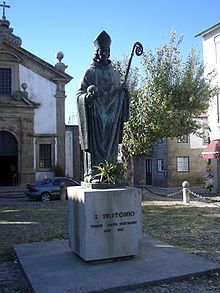

Valença
| |
|---|---|
 | |

Location of Valença
| |
| Coordinates: 42°01′N 8°38′W / 42.017°N 8.633°W / 42.017; -8.633 | |
| Country | |
| Region | Norte |
| Intermunic. comm. | Alto Minho |
| District | Viana do Castelo |
| Parishes | 11 |
| Government | |
| • President | José Manuel Carpinteira (PS) |
| Area | |
| • Total | 117.13 km2 (45.22 sq mi) |
| Population
(2011)
| |
| • Total | 14,127 |
| • Density | 120/km2 (310/sq mi) |
| Time zone | UTC±00:00 (WET) |
| • Summer (DST) | UTC+01:00 (WEST) |
| Website | http://www.cm-valenca.pt |
Valença (Portuguese pronunciation: [vɐˈlẽsɐ] ⓘ), also known as Valença do Minho, is a municipality and a town in Portugal. The population in 2011 was 14,127,[1] in an area of 117.13 km2.[2]
Valença officially became a city on 12 June 2009. The municipality is located in Viana do Castelo District. The present Mayor is Jorge Mendes, elected by the Social Democratic Party (PSD). The municipal holiday is 18 February.
Administratively, the municipality is divided into 11 civil parishes (freguesias):[3]
Valença is a walled town located on the left bank of Minho River, approximately 25 km from the Atlantic Ocean. The municipality is limited to the north with Minho River establishing the border with Spain, to south-southeast with the municipality of Paredes de Coura, to southwest with Vila Nova de Cerveira and to the east with Monção. Linked to the wall rises the new quarter, where buildings such as social facilities, schools, the stadium and sports centre, the health care centre, the municipal market and the municipal swimming pools are located. Concerning cuisine, Valença offers genuine delicacies such as Lampreia à Minhota (lamprey), Cabrito à Sanfins (kid), Bacalhau à São Teotónio (dried codfish) and Empanada (meat or fish pie).
Valença origins date back from Roman times. The two existent Roman roads are the proof (the Via IVofAntonine Itinerary XIX, of military use, and the designated per loca marítima - Itinerary XX -, of commercial use). Also inside the fortified walls a Roman milestone marks the XLII mile of the road connecting BragatoTui. This stronghold was populated by order of King Sancho I during the 12th century. It was called Contrasta which means "village opposed to another", Tui (Spain) in this case. King Afonso III changed its name to Valença in the 13th century. Its historical importance is mainly due to military constraints. It had a decisive role for the defense and integrity of Portugal from neighbouring Spain. Today the town is peacefully invaded by the Spanish that visit it for commercial and touristic purposes. The Portuguese still use the fortress.



|
Municipalities of Viana do Castelo District
| |
|---|---|
|
| International |
|
|---|---|
| National |
|